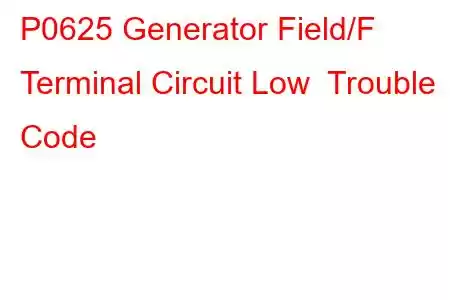P0625 Generator Field/F Terminal Circuit Low
OBD-II Trouble Code Technical Description
Generator Field/F Terminal Circuit Low
What does that mean?
This is a generic diagnostic trouble code (DTC) and applies to many OBD-II vehicles (1996-newer). That may include but is not limited to vehicles from Ford, Hyundai, Mercedes Benz, Sprinter, Land Rover, Kia, etc. Although generic, the exact repair steps may vary depending on year, make, model and powertrain configuration.
A stored code P0625 means that the powertrain control module (PCM) has detected a lower than expected voltage signal from the generator field coil circuit. The F simply reiterates the field coil control circuit is at fault.
The field coil is probably most recognizable from its windings which are visible through the vent holes on most alternators. The field coil surrounds the generator armature and remains stationary in the alternator housing. The armature spins inside the field coil which is energized using battery voltage. Each time the engine is started, the field coil is energized.
The PCM monitors the continuity and voltage level of the generator field circuit whenever the engine is running. The generator field coil is integral to generator operation and maintaining battery charge levels.
If a problem is detected in monitoring the generator field circuit, a code P0625 will be stored and a malfunction indicator lamp (MIL) may be illuminated. Depending upon the perceived severity of the malfunction, multiple failure cycles may be necessary for MIL illumination.
A typical alternator:
What is the severity of this DTC?
A stored code P0625 could result in a variety of drivability concerns, including a no-start and/or dead battery condition. It should be classified as severe.
What are some of the symptoms of the code?
Symptoms of a P0625 trouble code may include:
Charging system lamp illumination Engine drivability issues Inadvertent engine shutoff Delayed engine cranking Other stored codesWhat are some of the common causes of the code?
Causes for this code may include:
Open or shorted generator field control circuit Blown fuse or burnt fusible link Defective alternator/generator Faulty PCM PCM programming errorWhat are some P0625 troubleshooting steps?
A diagnostic scanner, a battery/alternator tester, a digital volt/ohmmeter (DVOM), and a source of reliable vehicle information will be required to diagnose a code P0625.
Consult your vehicle information source for technical service bulletins (TSB) that replicate the code stored, vehicle (year, make, model, and engine), and symptoms exhibited. If you find the appropriate TSB, it may yield helpful diagnostic.
Begin by connecting the scanner to the vehicle diagnostic port and retrieving all stored codes and freeze frame data. You will want to write this information down, just in case the code proves to be an intermittent one. After recording all pertinent information, clear the codes and test drive the vehicle until the code is reset or the PCM enters readiness mode. If the PCM enters readiness mode, the code is intermittent and will be more difficult to diagnose. The condition, which caused the P0625 to be stored, may even need to worsen before a diagnosis can be made. If the code is reset, continue with your diagnosis.
Use the battery/alternator tester to load-test the battery and make sure that it is sufficiently charged. If it is not, charge the battery as recommended and test the alternator/generator. Follow manufacturers recommended specifications for minimum and maximum voltage output requirements for the battery and alternator. If the alternator/generator is not charging, proceed to the next step in your diagnosis.
Use your source of vehicle information to obtain connector face views, connector pin-out charts, component locators, wiring diagrams, and diagnostic flow charts related to the code and vehicle in question.
Check to see if there is battery voltage on the alternator/generator field control circuit by using the appropriate wiring diagram and your DVOM. If not check system fuses and relays and replace defective parts as required. If voltage is discovered at the generator field coil control terminal, suspect a defective alternator/generator.
The field coil is an integral part of the alternator and cannot usually be replaced separatelyRead: 47


